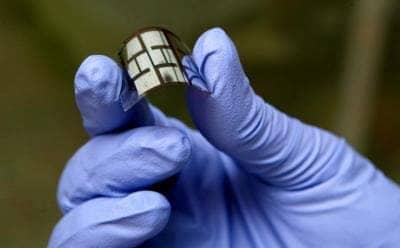
Solar cells constructed with microscopic leaf-like folds and wrinkles can produce 47% more electricity than similar flat cells – according to the researchers in the US who made the wrinkled cells. The team has also shown that the devices can exploit a wider range of the solar spectrum and are considerably more robust than their flat counterparts.
Crystalline silicon photovoltaic cells have been around for more than 50 years, but they are fragile, expensive and labour intensive to produce. Devices made from organic plastic semiconductors are flexible, lightweight and cheap, but they are less efficient. In order to make them commercially viable, scientists have been trying to boost the efficiency of plastic solar cells from just a few per cent towards 10–15% – compared with crystalline silicon devices, which have an efficiency of about 20%. Recently, a team at UCLA created organic cells with an efficiency of 10.6%, and the new leaf-mimicking technique could offer a way to increase that value still further.
Architectural inspiration
The traditional strategy for enhancing solar cells has focused on improving the performance of photovoltaic materials and reducing manufacturing costs. Looking at the geometric structure of cells is a relatively new and potentially fruitful avenue of research. That is because nature’s solar powerhouses – leaves – contain structures that trap and guide sunlight to maximize the amount of light that is harvested. Using the complex network of creases and undulations on the surfaces of leaves as inspiration, the researchers constructed photovoltaic cells with similarly uneven surfaces and found that electricity production shot up in comparison with flat cells.
Jongbok Kim and colleagues at Princeton University and the University of Pennsylvania were surprised at the impact of the geometric structures. “I expected that it would increase the photocurrent because the folded surface is quite similar to the morphology of leaves, a natural system with high light-harvesting efficiency,” says Kim. “But when I actually made organic solar cells with this concept, its effect exceeded my expectations.”
Curve control
The technique for making the wrinkles is nothing new. A rigid layer of crust atop a more flexible substrate creates instabilities that cause folds to form – a process that can be controlled with great precision. The team used ultraviolet light to selectively cure layers of optical adhesive, altering their elasticity to varying extents to induce stresses in the material. The result is ripples that repeat with periods of 1–5 µm. The team has classified the shallower ripples as wrinkles and the deeper ones as folds. The entire folded layer was then coated with the active photovoltaic polymer P3HT:PCBM.
For leaves and solar cells alike, the longer light remains in the photoactive regions, the better its chance of being absorbed. The shallow solar-cell wrinkles alter a photon’s angle of incidence slightly, curving and thereby lengthening its trajectory through the active material. The deeper folds offer an even more pronounced effect but the researchers found that a balance of the two works best.
Team leader Lynn Loo of Princeton University explains that once the light is in the active layer of the device, an encounter with a deep fold will guide it out of the active layer. “So you have a sweet spot,” says Loo. Indeed Loo and colleagues found that when more than 11% of the surface is wrinkled, “you’re guiding light in but you’re also guiding light out and shortening how much time it can spend in the active layer”.
Surprise benefits
What is remarkable about the wrinkled P3HT:PCBM cells is that their enhanced wave-guiding effect actually extends the range of wavelengths that the material can absorb. In particular, the device performs well with light in the near infrared, where the efficiency of most solar cells tails off. Indeed, the design achieves about 600% greater absorption at these wavelengths than compared with flat P3HT:PCBM cells. In addition, the wrinkled cells retain their effectiveness completely when bent, where conventional flexible cells experience a 70% drop in output. This marks them out for use in fabrics, portable devices and on curved and uneven structures.
The work is described in Nature Photonics.



